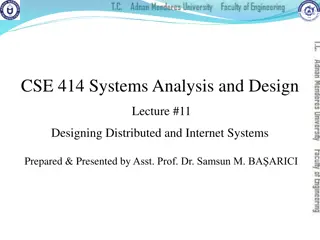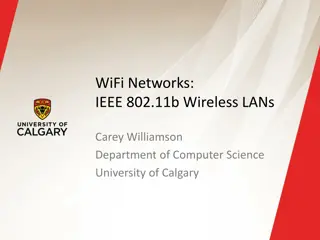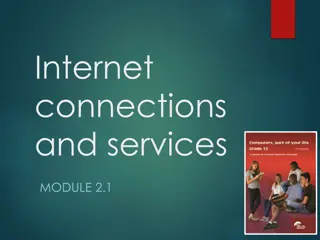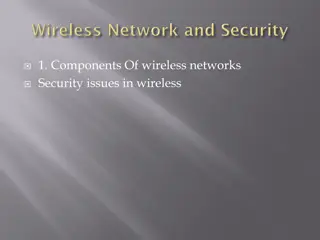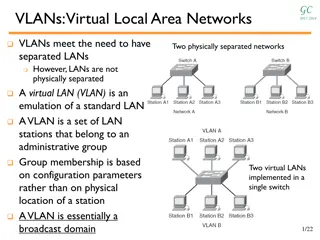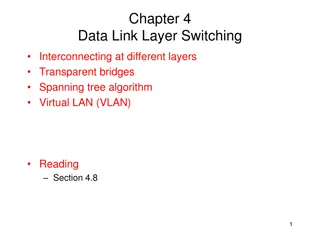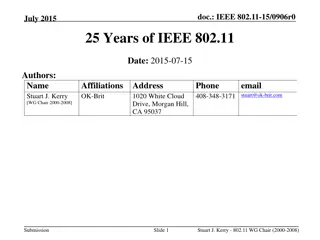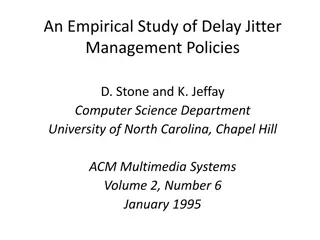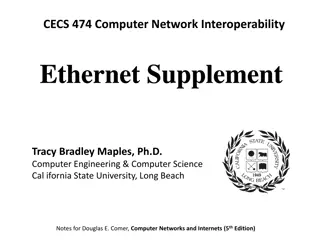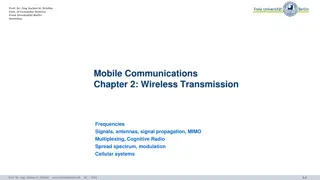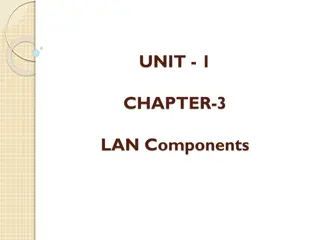Designing Distributed and Internet Systems
Learn about the design considerations for distributed and internet systems, including file server versus client/server environments, cloud computing trends, internet standards, and system development life cycle. Explore designing systems for local area networks (LANs) and the process of creating dis
2 views • 51 slides
Understanding IEEE 802.11b Wireless LANs
IEEE 802.11b wireless LAN standard shares similarities with Ethernet LANs but also has distinct differences due to its wireless nature. It operates in the industrial, scientific, and medical RF bands, supporting features like infrastructure mode, multiple channel access protocols, and DSSS signal sp
3 views • 17 slides
Understanding Internet Connections and Services
Explore the world of internet connections and services, from local area networks (LANs) to wide area networks (WANs). Learn about the hardware and software required to connect devices, the purpose of WANs, and examples of WAN implementations in banks and the global internet.
0 views • 19 slides
Understanding Token Ring Technology in Computer Networks
Token Ring, developed by IBM, is a networking technology that uses a token passing scheme for data transmission. Devices on the network take turns transmitting data by holding a token and releasing it after data transfer. Unlike Ethernet, Token Ring offers unique benefits and operates efficiently in
2 views • 17 slides
Wireless LANs: Components and Security Issues
Wireless LANs use radio waves to connect users within a building or campus. This technology overview covers IEEE 802.11 standards, migration to WLANs, and connection to wired LANs through access points. Understanding the specialized protocols, security considerations, and performance differences is
0 views • 29 slides
Understanding VLANs in Computer Networking
VLANs (Virtual Local Area Networks) allow for the logical separation of LANs without physical segregation. They group network stations based on administrative criteria rather than physical location. VLANs enhance security, facilitate group collaboration, and optimize network traffic by segregating d
0 views • 22 slides
Understanding LAN Interconnection and Switching Technologies
This content delves into the concepts of interconnecting LANs, exploring the reasons and methods behind partitioning LANs and interconnecting them at different layers using repeaters, hubs, bridges, switches, and routers. It also highlights the differences between these devices in terms of their net
0 views • 21 slides
Celebrating 25 Years of IEEE 802.11 Standards Working Group
Reflecting on the last 25 years of the IEEE 802.11 Standards Working Group for Wireless LANs through a series of submissions by Stuart J. Kerry, the former WG Chair. The submissions cover interesting facts, humorous anecdotes, and a tribute to the hard work behind this widely-used worldwide standard
0 views • 18 slides
Abstract Digital Art Collection
This collection features abstract digital artwork with unique names like "izlo.ds.le.okbv.yl.dh.fuxjkuh.dk.egro", "lkh.kus.ds.m.s", "ekk.ds.okbv.y.dh.fuxjkuh", "ukotkr.ds.okbv.y.dh.fuxjkuh", and "eq.lans.k". Each piece showcases a blend of colors, shapes, and textures in a digital format, inviting v
0 views • 5 slides
Understanding Wireless Networks: Types and Applications
Wireless networks utilize wireless data connections to connect network nodes and share resources. They include Wireless Personal Area Networks (WPAN), Wireless LAN, Wireless WAN, Wireless Broadband, and Wireless Cellular. Each type has specific characteristics and applications, such as linking perso
0 views • 29 slides
An Empirical Study of Delay Jitter Management Policies
This study explores delay jitter management policies to support interactive audio over LANs, focusing on display queue management to minimize gaps in playout. The paper evaluates different queue management policies, including I-policy and E-policy, along with queue monitoring in the context of an em
0 views • 37 slides
Understanding Ethernet and Multiple Access Protocols in Computer Networks
Exploring the fundamentals of Ethernet and multiple access protocols in computer networks, this content discusses the two primary categories of multiple access protocols - contention access and controlled access. It delves into topics such as CSMA/CD, LANs, performance of multiple access schemes, ad
0 views • 7 slides
Understanding Local Area Networks: Basics, Advantages, and Disadvantages
A Local Area Network (LAN) serves various functions such as file serving, print serving, video transfers, and more. LANs offer advantages like resource sharing, private ownership, and secure transfers, but come with disadvantages such as costliness and maintenance issues. Different LAN topologies li
1 views • 50 slides
Understanding VLANs and Virtual LANs in Networking
This detailed guide explores VLANs (Virtual LANs) in network configuration, covering concepts like switch hosts, aggregation, subnets, routers, and port configurations. Learn about setting up VLANs, managing broadcast domains, ARP requests, and more to enhance network security and performance.
0 views • 28 slides
Understanding Wireless Communication Frequencies and Regulations
Explore the world of wireless communication frequencies, signals, and regulations explained by Prof. Dr.-Ing. Jochen H. Schiller from Freie Universität Berlin, Germany. Discover the various frequency ranges from VLF to EHF, examples for mobile communication frequencies, and regulations in Europe, U
0 views • 44 slides
Local Network and File Sharing Workshop Overview
Exploring the concepts of local area networks (LANs), intranets, and practical aspects of sharing files and printers on a network. The workshop delves into the structure of the University of Alkafeel network, including hotspot settings and ad hoc network configurations. Learn about USB printer shari
0 views • 30 slides
LAN Hardware Components and Connectivity Mediums
LAN hardware components, such as cables, repeaters, hubs, switches, and network interface cards, play a crucial role in transmitting electric signals between devices. Cables are the primary connectivity medium, with factors like bandwidth and distance affecting data transmission. External disturbanc
0 views • 26 slides
